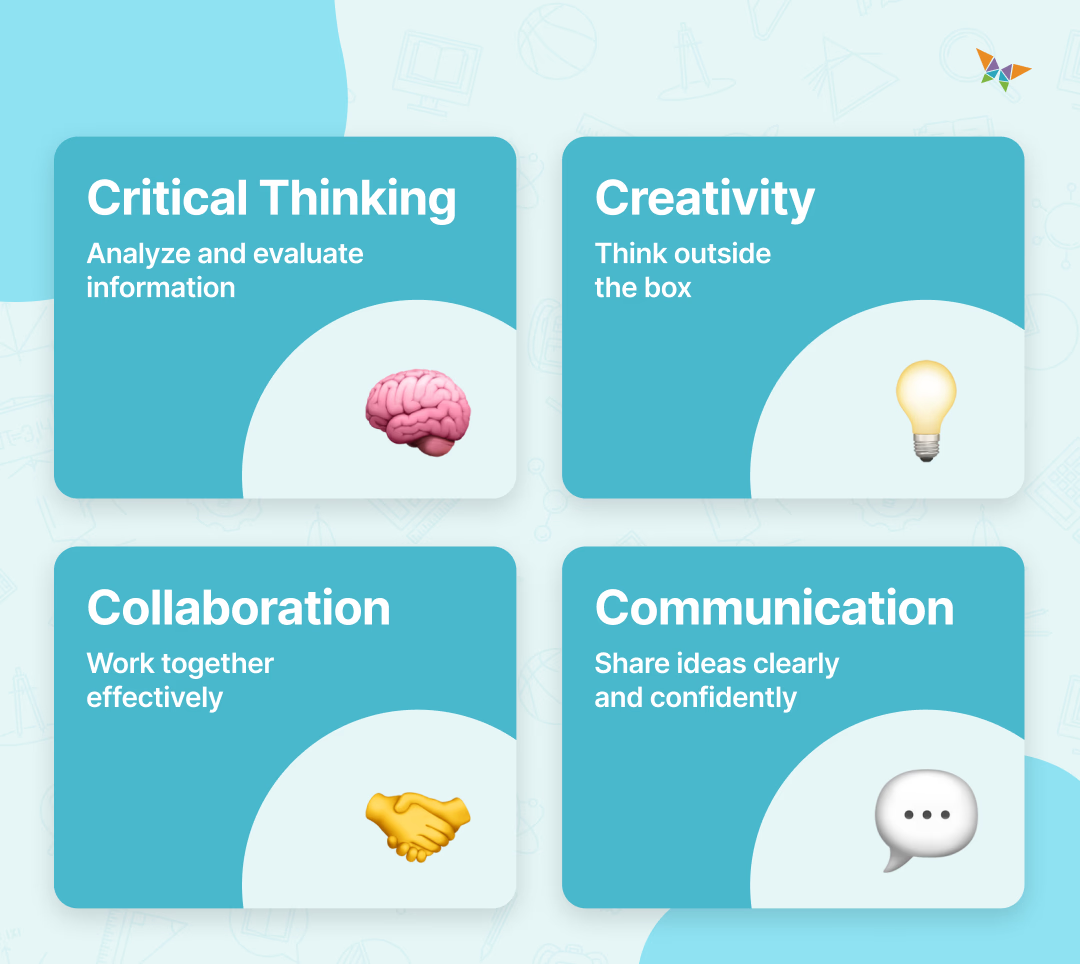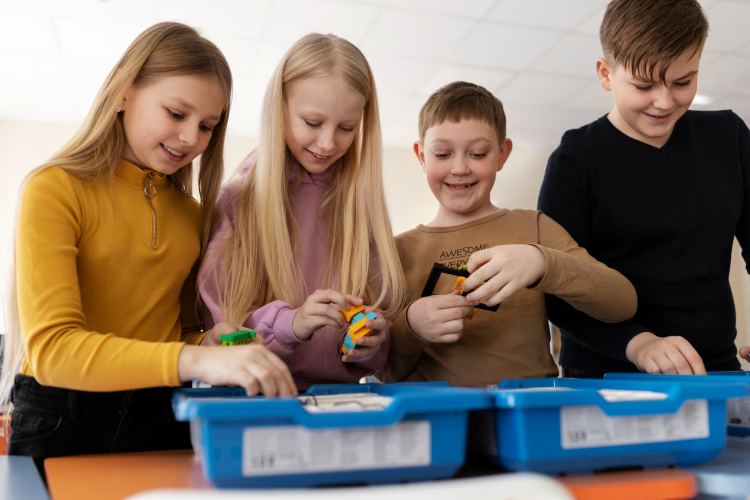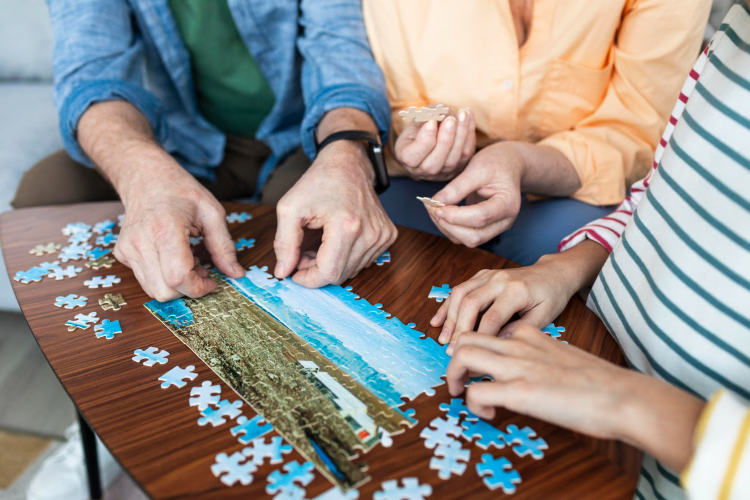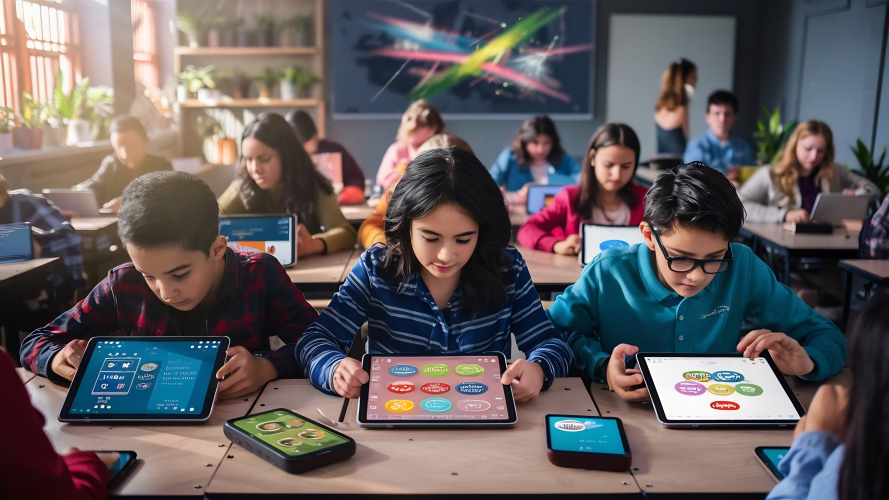Picture this:
A classroom where students are not just listening but genuinely thinking and sharing their learning. Imagine the energy when they’re solving real problems, coming up with ideas, and learning to work as a team. That’s the magic of bringing the 4C’s of learning skills into everyday teaching.
In this blog, we’ll cover:
- Understanding the 4C’s of Learning Skills
- Practical Strategies to Foster the 4C’s of Learning Skills in the Classroom
- Conclusion
Each of these skills brings a unique, impactful dimension to learning, creating a classroom experience that goes beyond rote memorization.
Now, let’s dive into what the 4C’s of Learning Skills truly mean and discover how they can change your teaching approach!
The 4C’s—critical thinking, creativity, collaboration, and communication—are fundamental learning skills every student should develop.
You've likely noticed students rushing through assignments, leading to lower-quality work.
Instead of feeling frustrated, ask yourself, "Why is this happening?" Maybe they need help with time management, which is one of the essential learning skills for students.
A solution could be offering a time-management workshop or breaking assignments into smaller tasks, helping them develop better organization and focus. By sharing these ideas with your students, you're addressing immediate challenges and nurturing essential learning skills for students that will benefit them in the long run, both academically and in life.
That's critical thinking—identifying the problem, finding solutions, and positively impacting your classroom.
Students really come alive when they get the chance to be creative. Imagine they’re working on a school event campaign—brainstorming ideas, designing posters, and even filming a video.
It’s not just about finishing tasks; it’s about critical thinking in action. Students analyze the problem, find solutions, and turn ideas into reality. When creativity is involved, they think outside the box, take pride in their work, and enjoy the process—all while learning new skills. This blend of critical thinking, creativity, and skill development helps students tackle challenges confidently.
It’s all about helping them solve problems, find creative solutions, and see their ideas come to life.
In today’s world, teamwork is everything, and learning to collaborate is key.
Imagine a group of students working on a science project—dividing up tasks, bouncing around ideas, and figuring out how to communicate effectively. It’s more than just finishing a project; it’s about learning to work with others and developing critical 21st century learning skills like collaboration, communication, and problem-solving. These skills help them navigate challenges and prepare for success in the modern world.
This collaboration helps students build strong interpersonal skills and a sense of community in the classroom. By working together, they achieve their goals while recognizing the importance of learning skills like communication, adaptability, and problem-solving, which are vital to their academic success and beyond.
Effective communication is at the heart of successful interactions. Students need to share their ideas clearly and confidently, whether they’re writing, speaking, or presenting.
Think about a student giving a presentation on their favorite book, speaking with enthusiasm and clarity, and pulling their classmates into the story. Experiences like these boost students' confidence and help them learn how to express their thoughts, connect with others, and focus on learning new skills like public speaking and storytelling. These skills are valuable for their academic and personal growth.
Integrating these 4C’s of learning skills into daily teaching is a transformative process that makes the classroom environment more dynamic and engaging for students. It also fosters essential 21st-century learning skills such as critical thinking, creativity, collaboration, and communication, preparing students for success in a rapidly evolving world.
Get students excited about real-life projects that boost critical thinking and teamwork! When they tackle real issues, they’re not just learning—they’re analyzing, researching, and coming up with solutions. It’s hands-on, and it makes a real impact. This approach emphasizes the importance of learning skills like problem-solving, collaboration, and creativity, equipping students with the tools they need to succeed in school and life.
Implementation: Assign them a relevant issue, like waste management, and let them dig into research and brainstorm solutions.
Let students bring concepts to life through art—it’s a great way to keep them engaged and make learning memorable. Creative expression helps them connect with the material and explore it from different angles while developing essential learning skills for students, like creativity, critical thinking, and problem-solving.
Implementation: After a lesson, encourage students to show what they’ve learned with creative projects—think paintings, skits, or digital presentations.
Group activities like jigsaw or think-pair-share help students collaborate, share ideas, and build strong communication skills. They also promote 21st-century learning skills like collaboration, critical thinking, and adaptability, preparing students for success in a dynamic world.
Implementation: Divide the class into small groups and assign each one a unique part of the lesson or a specific problem to solve. Let them discuss, explore, and then present their findings to the rest of the class. It’s a great way for students to teach and learn from each other.
Reflection and discussion are powerful tools for building self-awareness and communication skills. When students take time to look back on their work, they start connecting what they’ve learned to real-life situations, deepening their understanding and ownership of their learning.
Implementation: After completing a project, hold a class discussion where students share what went well, the challenges they faced, and what they learned. Encourage open reflection and active listening to help students gain insights from each other's experiences.
Imagine students collaborating on a Google Doc or designing a presentation in Canva together. Digital tools like these make teamwork easier and learning more interactive while building crucial digital skills. They also emphasize the importance of learning skills like collaboration, communication, and problem-solving, preparing students for success in the future.
Implementation: Encourage students to use these platforms for group projects. Working together on shared documents or presentations brings their ideas to life visually and builds their confidence with tech in an academic setting.
When students teach each other, it strengthens their understanding and boosts their confidence. Peer teaching also builds communication skills and helps students appreciate different perspectives.
Implementation: Set up peer-led study groups or mini-workshops. Allow students to pick a concept they’ve mastered and explain it to their classmates. This approach reinforces their knowledge while giving others a fresh take on the topic.
Want your students to embrace skills like critical thinking, creativity, collaboration, and communication? The best way to teach these is to live them yourself! By showing how you tackle challenges, think outside the box, and work with others, you set a powerful example they can follow.
Implementation: Try bringing your students into your lesson planning process. Chat with them about how you come up with ideas, add a creative twist, or adjust when things don’t go as planned. Let them see real collaboration and problem-solving happening right in front of them.
Integrating the 4C’s of learning skills into everyday teaching enriches the educational experience for both teachers and students. By focusing on critical thinking, creativity, collaboration, and communication, we prepare our students for the challenges of the 21st century. Learning skills extend beyond the classroom; they are vital for personal and professional success.
As you implement these strategies in your classroom, remember that every small step contributes to a larger goal of nurturing well-rounded individuals capable of thriving in any environment.
For teachers looking to succeed in their teaching career through upskilling courses, consider scheduling a free call with a teacher career expert.
Let’s inspire the next generation of learners to embrace the learning skills that will empower them throughout their lives. We set the foundation for a brighter, more innovative tomorrow by fostering these essential skills today.
















